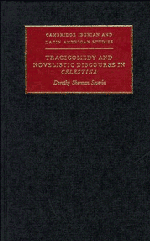Book contents
- Frontmatter
- Contents
- List of illustrations
- Preface
- Abbreviations
- 1 Introduction: Celestina and novelistic discourse
- 2 The prefatory material: the author's ambivalent intentions
- 3 Genre and the parody of courtly love
- 4 From parody to satire: clerical and estates satire
- 5 Verbal humour and the legacy of stagecraft
- 6 The rhetorical shift from comedy to tragedy: ironic foreshadowing and premonitions of death
- 7 Is Melibea a tragic figure?
- 8 Pleberio's lament, Cárcel de Amor, and the Corbacho
- 9 Conclusion: Rojas' ambivalence towards literature
- Notes
- Bibliography
- Index
- CAMBRIDGE IBERIAN AND LATIN AMERICAN STUDIES
4 - From parody to satire: clerical and estates satire
Published online by Cambridge University Press: 05 March 2012
- Frontmatter
- Contents
- List of illustrations
- Preface
- Abbreviations
- 1 Introduction: Celestina and novelistic discourse
- 2 The prefatory material: the author's ambivalent intentions
- 3 Genre and the parody of courtly love
- 4 From parody to satire: clerical and estates satire
- 5 Verbal humour and the legacy of stagecraft
- 6 The rhetorical shift from comedy to tragedy: ironic foreshadowing and premonitions of death
- 7 Is Melibea a tragic figure?
- 8 Pleberio's lament, Cárcel de Amor, and the Corbacho
- 9 Conclusion: Rojas' ambivalence towards literature
- Notes
- Bibliography
- Index
- CAMBRIDGE IBERIAN AND LATIN AMERICAN STUDIES
Summary
Whether or not there is ecclesiastical satire in Celestina has been the subject of some debate in recent criticism. In any event, from the angle of Rojas' contemporary audience various passages seem to fall into this category, whatever the authors' ulterior motives might have been. The primitive author begins this type of satire in a promising vein with Celestina's invention of ‘moza’ [wench] and ‘fraile gordo’ [fat friar] to divert Sempronio's suspicions of Elicia's behaviour. Sempronio rises to the bait with his scandal-mongering response:
sempronio Por mi vida, madre, ¿qué fraile?
celestina ¿Porfias? El ministro, el gordo' (57)
[sempronio Now, as you love me, good mother, tell me what friar is it?
celestina Lord, how earnest you be … it is that fat friar, (the minister)].
This ecclesiastical satire is amalgamated with estates satire later in Act I on the occasion of Pármeno's multiple description of Celestina:
Asaz era amiga de estudiantes y despenseros y mozos de abades … Subió su hecho a más: que por medio de aquellas comunicaba con las más encerradas, hasta traer a ejecución su propósito, y aquestas en tiempo honesto, como estaciones, procesiones de noche, misas del gallo, misas del alba y otras secretas devociones. Muchas encubiertas vi entrar en su casa; tras ellas hombres descalzos, contritos y rebozados, desatacados, que entraban allí a llorar sus pecados.
(61)- Type
- Chapter
- Information
- Tragicomedy and Novelistic Discourse in Celestina , pp. 49 - 60Publisher: Cambridge University PressPrint publication year: 1989

